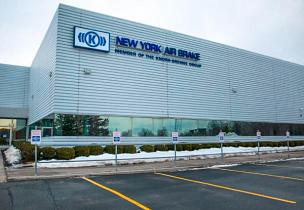Watertown’s New York Air Brake building a ‘bridge to future’ in train brake technology
WATERTOWN — A city business will be riding in the forefront of the anticipated growth of the passenger rail system industry in the coming years because of its technological advancement regarding brakes.
Watertown-based New York Air Brake along with its sister company, Westminster, Md.-based Knorr Brake Company, have developed the EE-26™ brake system, engineered for safety, performance, its “uptime” and lower cost of ownership.
“It’s a bridge to the future of passenger car brake control,” Michael Gibbs, KBC’s deputy director of sales said in a news release. “North America passenger railcars have been equipped with the same conventional pneumatic brake control for decades. Now, with the adoption of electropneumatic control technology significantly increasing in North America, we’ve engineered the EE-26 brake system with the capability to handle both true pneumatic and electropneumatic control of a braking system.”
The difference
In a traditional purely pneumatic system, individual passenger car brakes are activated in response to changes in air pressure through a control pipe that runs the length of a train. In an electronically controlled pneumatic (ECP) system, the brakes respond to electronic signals sent from the locomotive.
ECP braking — widely used across the rail industries in Europe, Australia, Africa, the Middle East, and Asia — provides increased safety, improved train-level brake performance, and better diagnostics.
“We often relate the comparative communications speed of pneumatic and ECP signals through a brake system to the speed of sound versus the speed of light,” said Brendan Crowley, NYAB manager of sales and systems engineering. “In addition to the safety and performance enhancements of greater signal speed, ECP systems deliver real-time diagnostic information and alerts to operators and maintenance staff, which benefits train engineers and technicians, improves train handling, and decreases maintenance downtime.”
The local New York Air Brake facility on Starbuck Avenue was key in developing the technology, said Greg Dalpe, NYAB’s senior vice president for sales and marketing.
“Watertown is our company headquarters and the home of our engineering research and development and product development leadership,” Mr. Dalpe said in an email to the Times. “The core of the EE-26 brake system will be manufactured in Watertown alongside its freight car cousin, the EP-60 brake system.”
The EP-60 system is an ECP brake system that NYAB says provides a dramatic improvement in train handling for long, heavy haul trains.
A total of 360 production and salaried workers are employed at New York Air Brake in Watertown.
The new EE-26 brake system is based upon NYAB’s freight car product line, which is designed and manufactured in Watertown.
“The EP-60 system helps train operators shorten stopping distance and improve safety, extend equipment life and lower fuel cost,” Mr. Dalpe said. “In this joint development effort, we built upon our freight car experience and applied it to the needs of the transit industry, in partnership with KBC on packaging the product to meet the specific space and mounting requirements of the transit passenger cars.”
The EE-26 system has been in a “very successful” field trial in North America since 2014, accumulating more than 2 million miles of service.
NYAB/KBC expects to begin taking orders for EE-26 this year for new transit car applications in 2022.
The system increases the recommended valve overhaul period to 10 years, more than doubling the previous four-year period. The EE-26’s modular design, using the preferred panel-mounted valve approach from other transit applications, saves space, makes installation easier for car manufacturers, and provides more accessible maintenance compared to existing traditional pipe-mounted equipment.
The EE-26 utilizes the Association of American Railroads approved “Car Control Device” as the foundation of its brake control operation, leveraging service-proven components for system reliability and smooth product introduction.




